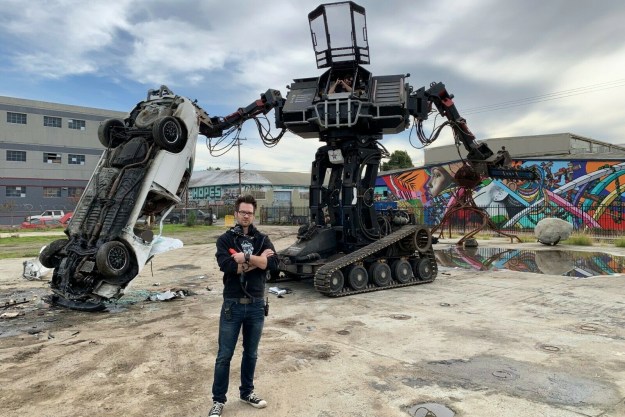Atlas Shrugged may be the name of Ayn Rand’s veritable doorstop of a novel, but no-one is shrugging indifferently when it comes to Boston Dynamic’s amazing Atlas robot. For the past five years, Atlas has lived up to A.I. expert Gary Bradski’s 2013 statement that “a new species, Robo sapiens, [is] emerging.”
Designed to carry out missions like search and rescue — and far, far more — the bipedal robot has remained on the front line of cutting edge robotics since its unveiling. Here are 7 of its most notable milestones:
Atlas debuted
July 2013
Standing 6-foot-2-inches and tipping the scale at 330 pounds, the first-gen Atlas makes its public debut in mid-2013.
Although Boston Dynamics is the name most associated with Atlas, it’s not the only group which is part of its creation. It’s a collaboration between DARPA and multiple tech companies, which also includes Sandia National Laboratories and iRobot, the maker of the infamous Roomba vacuum line. Boston’s work on Atlas is modeled on its previous PETMAN humanoid robot, along with its BigDog research.
Its first goal is to compete in the 2013 DARPA Robotics Challenge. Although undoubtedly impressive, DARPA program manager Gill Pratt compares the prototype of Atlas to a young kid, saying that a “one-year-old child can barely walk, a one-year-old child falls down a lot… This is where we are right now.”
Atlas balanced
October 2013
In an early showcase of Atlas’ impressive agility, Boston Dynamics uploads a video showing the robot balancing on one leg, jogging over rocks, and being hit with projectiles. If it had a beer in its hand, we’d write this one off as fraternity hazing!
Atlas shrunk
January 2015
Before we have time to even get used to the O.G. Atlas, it is replaced by Atlas 2.0. This slimmed-down model carries over only the lower legs and feet of the robot’s original design. It now boasts lighter materials, improved articulation, extra sensors and perception computers, and much quieter operation.
The most important improvement of all, though? It’s now wireless, untethered, and entirely battery powered. At the 2015 DARPA robotics finals, Atlas successfully completes the course; coming in close second place behind the Korean team Kaist’s DRC-Hubo robot.
Atlas shrunk… again
February 2016
Boston Dynamics debuts a new, smaller version of Atlas. Now standing at just 5-foot-9-inches, a head shorter than the original models, it is designed to be able to operate both indoors and outdoors, across a range of terrain — including snow.
Atlas now boasts new sensors, Lidar technology to avoid obstacles, and more.
Atlas fell
August 2017
Anyone who has ever done a live tech demo knows how, regardless of how well things work in the lab, problems can and will happen. That’s exactly what goes down during a Boston Dynamics presentation at the Congress of Future Science and Technology Leaders. At the end of its time on stage, Atlas heads to the back — only to trip over a stage light and take a Buster Keaton-like pratfall.
“I wish I could pretend it was supposed to do that,” Boston Dynamics CEO Marc Raibert tells the audience. Suddenly a Terminator-style robot takeover doesn’t seem so scary!
Atlas flipped
November 2017
How do you recover from accusations that you’re a little bit clumsy? Simple: You pull off a flawless gymnastics routine that ends with you performing a picture-perfect backflip. At least, that’s the approach that Boston Dynamics takes with Atlas after its embarrassing stage-tripping demo.
Seeing a 5-foot-9-inch robot perform this feat underlines just how far it has come, while showcasing its amazing agility, balance, and control. Faith in Atlas: restored.
Atlas jogged
May 2018
Giant aerial somersaults are pretty stonking impressive, but unless your Michelle Pfeiffer’s Catwoman very few people use backflipping as their primary form of locomotion. That’s why the recent video of Atlas jogging is so impressive.
While slightly less Olympics-worthy, it’s a demonstration of a complex ability that would be far more important for a real world bipedal robot to master.
Editors' Recommendations
- Evolving, self-replicating robots are here — but don’t worry about an uprising
- The latest wild idea for space exploration? Robots made from hunks of ice
- Boston Dynamics’ Spot robot gives New Zealand sheepdogs a run for their money
- Boston Dynamics’ remarkable robot dog has landed its first gig
- Ballie is a rolling robot from Samsung that can help around the smart home


